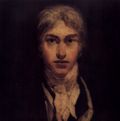William Turner
Joseph Mallord William Turner (Covent Garden 1775 - London 1851) was a British Romantic painter and printmaker. Important artistic influences upon Turner during the 1790s were Thomas Gainsborough, Michael Angelo Rooker, Philippe Jacques de Loutherbourg, Henry Fuseli and Richard Wilson. [1] In 1802, when he was only 26, he became a full member of the Royal Academy, the youngest member ever so admitted. He traveled constantly in England and abroad (Venice). A prolific artist, Turner produced over 550 oil paintings, over 2,000 highly detailed and finely finished watercolours, and some 30,000 works on paper. [2]
Turner is perhaps the most famous English Romantic landscape artist. He became known as "the painter of light", perhaps inspired by the 'year without a summer', and the amazing sunsets that resulted from it. [3] The Shipwreck, (1805) [4] shows his emphasis on luminosity, and dramatic subjects. He is considered not only Britain's greatest painter but arguably the finest landscape and marine painter ever. [5]
From 1807 he published a series of landscape prints known as the Liber Studiorum ('Book of Studies'), which demonstrated his abilities in every area of landscape art. [6]
There are many aspects of Turner's art that can displease — his clumsily drawn and sometimes ludicrously posed landscape figures... but he remains a giant in the watercolor tradition for his incredibly innovative technique and his increasing fascination with light and atmosphere as the fundamental subject of a painting. Turner's impact on Victorian art was stupendous. [7] Turner anticipated French Impressionism.
"The father of modern art", John Ruskin, 1843
Shipweck of the Minotaur, ca. 1810
- Continue to: William Turner / Gallery
See also
- English Painting
- Painting Schools
- Gallery of Seascapes
- Antony van Dyck
- Sir Joshua Reynolds
- John Constable
- Claude Lorrain
- Maritime Painting Gallery
External links
- William Turner Web Gallery of Art.
- J.M.W.Turner in Venice
- Fame and the Founding Father By Joseph Phelan.
- Joseph Mallord William Turner Watercolor artists.
- The story behind The Fighting Temeraire Britain's favourite painting.
- British Painters.
- Joseph Mallord William Turner.
MAKING ART WITH ART





